There are so many ways you can go about increasing your ecommerce traffic.
But we don’t just want to help you increase your traffic for the sake of it…
We want to ensure you’re getting the right traffic:
- People who are interested in your niche
- People who would like to join your mailing list
- People who will become customers
This isn’t easy to do—increasing the traffic to your ecommerce site is a massive challenge.
Yet, giving up would be a big mistake.
In this article, we’re going to explore six super-specific strategies and tactics you can use to effectively increase your ecommerce traffic.
Ready to dive in?
%(tableofcontents)
1. Grow Your Lists
Building lists is one of the BEST ways to increase traffic to your ecommerce store.
And I’m not just talking about email lists.
In 2024, you need to be building lists across multiple media and platforms to communicate with customers, leads, and prospects in whichever way they prefer.
This could mean:
- Building a list on Facebook Messenger
- Whatsapp Broadcast lists
- Creating an email list
When someone visits your site, you want them to purchase from your store. But realistically, only a fraction of visits will result in an instant sale.
Where you begin to make the real money is by capturing those fleeting visitors to a list and keeping in regular contact with them as you nurture them through your funnel.
Building lists is proven to be a rewarding process.
Firstly, lists are AMAZING for driving traffic back to your site. At Buffer, our mailing list is the #1 referrer of traffic to our new content on the day we publish it:

And secondly, an email marketing survey of 73 companies found that for every $1 spent on email marketing, the average return on investment is $50![*]
Not only is email a great way to drive repeat traffic to your ecommerce site, but it’s also a brilliant way to increase your revenue.
And that’s just email; there are multiple platforms to grow your lists.
For example, brands are seeing CRAZY high open rates, clicks, and engagement with Facebook Messenger lists right now:
- HubSpot is seeing average open rates of 80% and click rates of 13% (compared to email open rates of 33% and click rates of 2.1%)
- Erstwilder has seen 80% of customers reply to order notifications; whereas before, only a few replied to email order receipts[*]
So you can see the benefits of building lists, right?
Next, we’ll cover a few ways you can quickly start to grow your distribution lists.
Add a Scroll Box
Scroll Box can help you turn your website visitors into subscribers.
As a visitor scrolls down the page of your store, a polite CTA peeks up from the corner of the page, offering to take their email address.
Here’s an example of how Sumo is growing their Facebook Messenger list using Scroll Box:
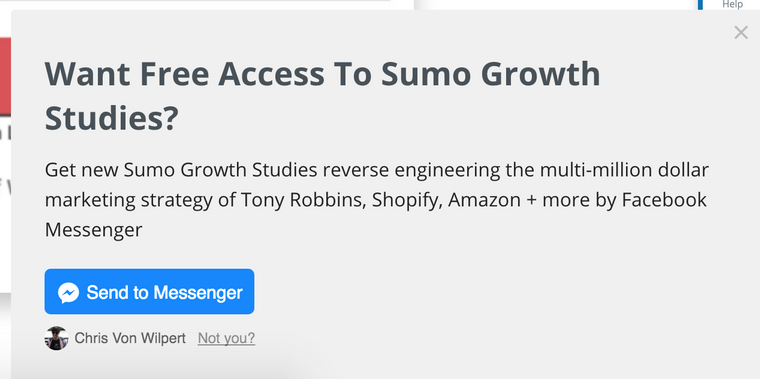
Click here to see how it works and get a free surprise sent to your Facebook Messenger.
Using Scroll Box’s advanced targeting, this popup appears for users who have been referred to the page directly from Facebook.com (so it’s easy to assume they’ll be active on Messenger, too). Once a subscriber, everyone on Sumo’s Messenger list will receive each new post we publish directly within Messenger.
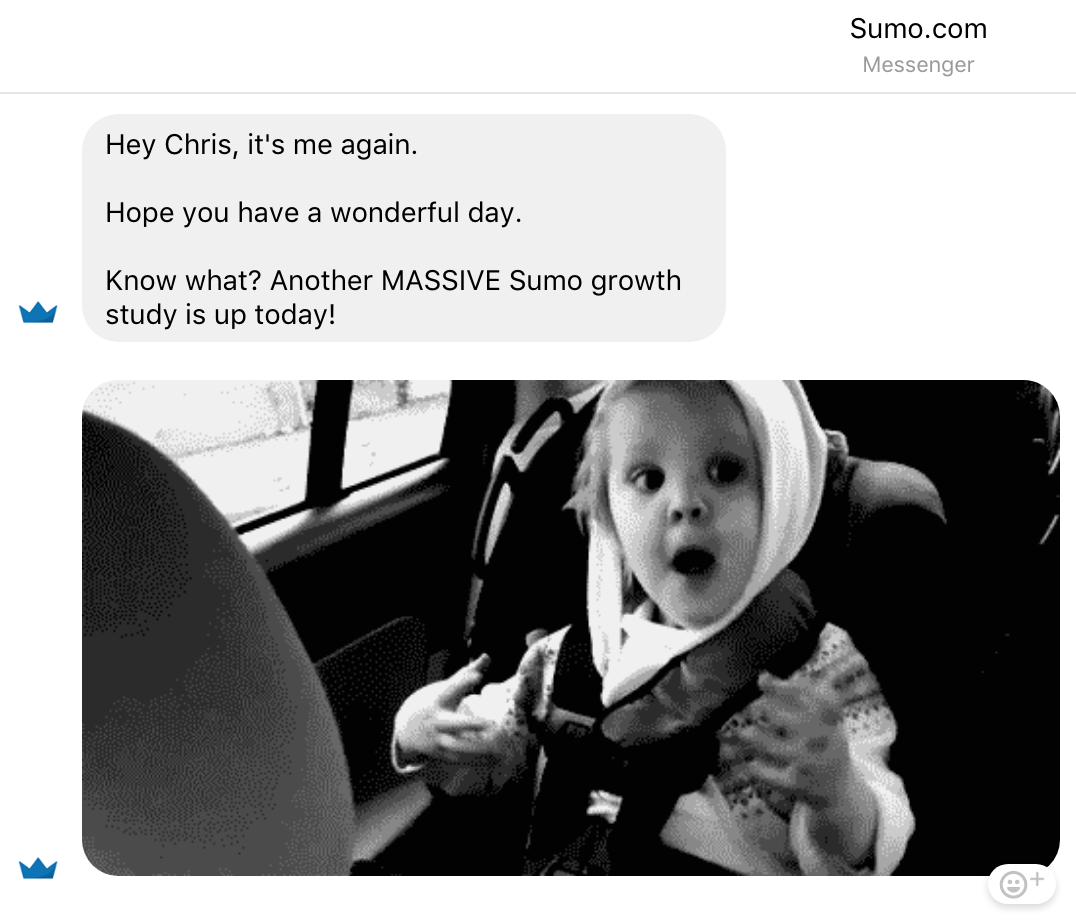
Add opt-in forms across your store
Opting into your lists should be super-simple for your website visitors. They should ALWAYS be able to see where they can opt-in and how. You should never make them go searching.
For example, Heyday Footwear uses a Welcome Mat to drive awareness of their free shipping offer and encourage visitors to opt-in to their list for further offers:
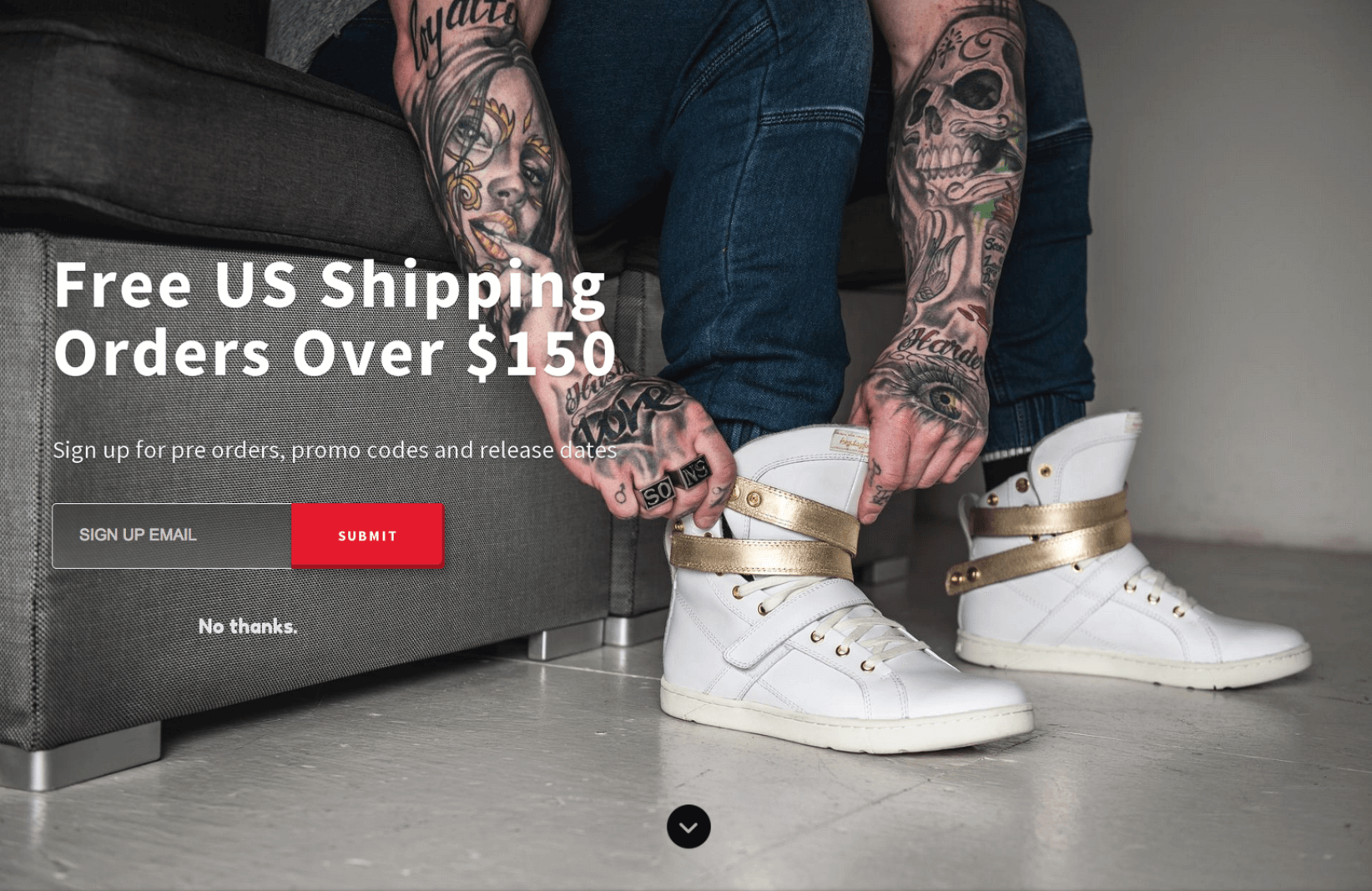
Malkin and Toad use List Builder to create a pop-up offering 20% discounts to visitors who join their mailing list:
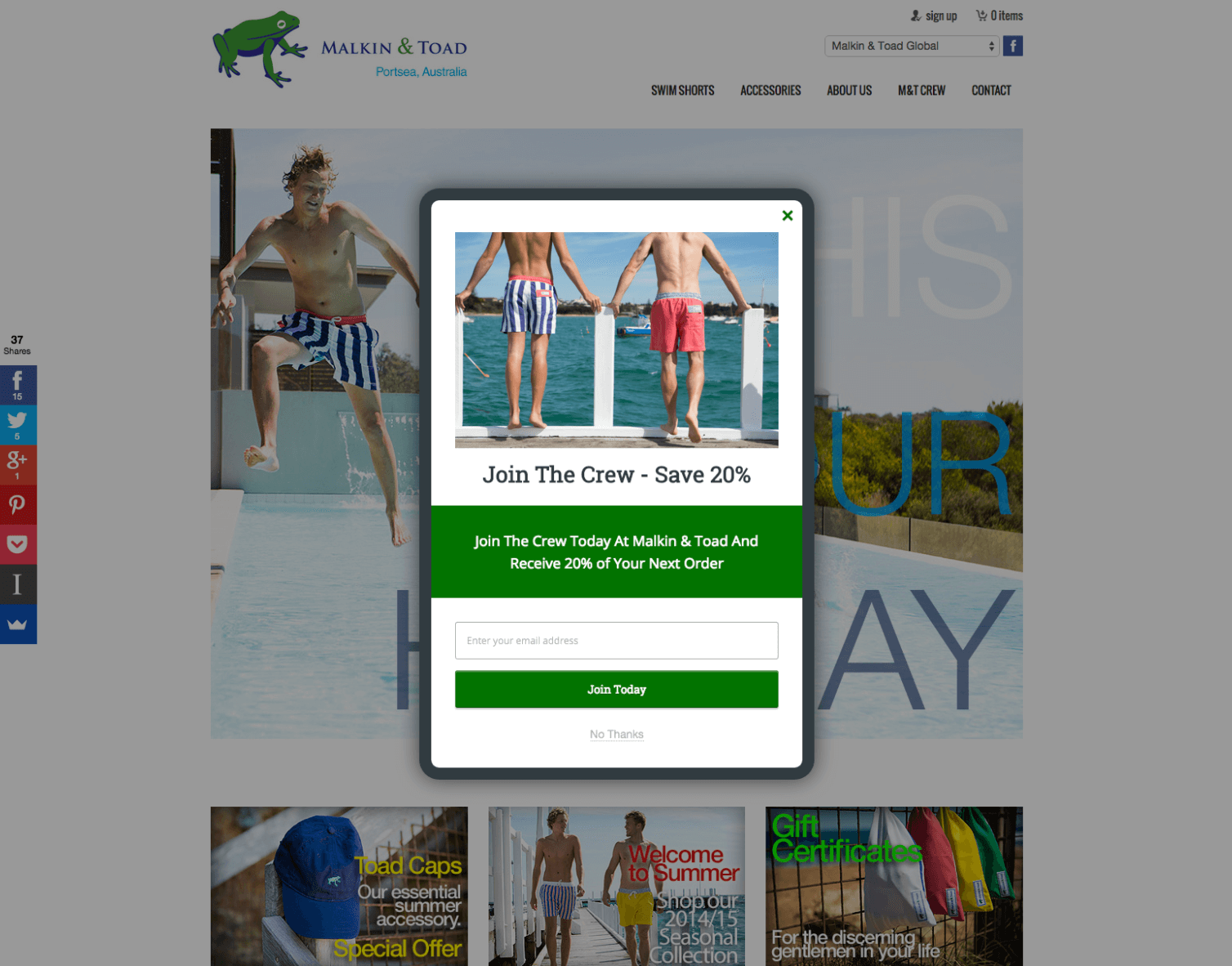
A few more places you can add opt-ins include:
- The footer of your store
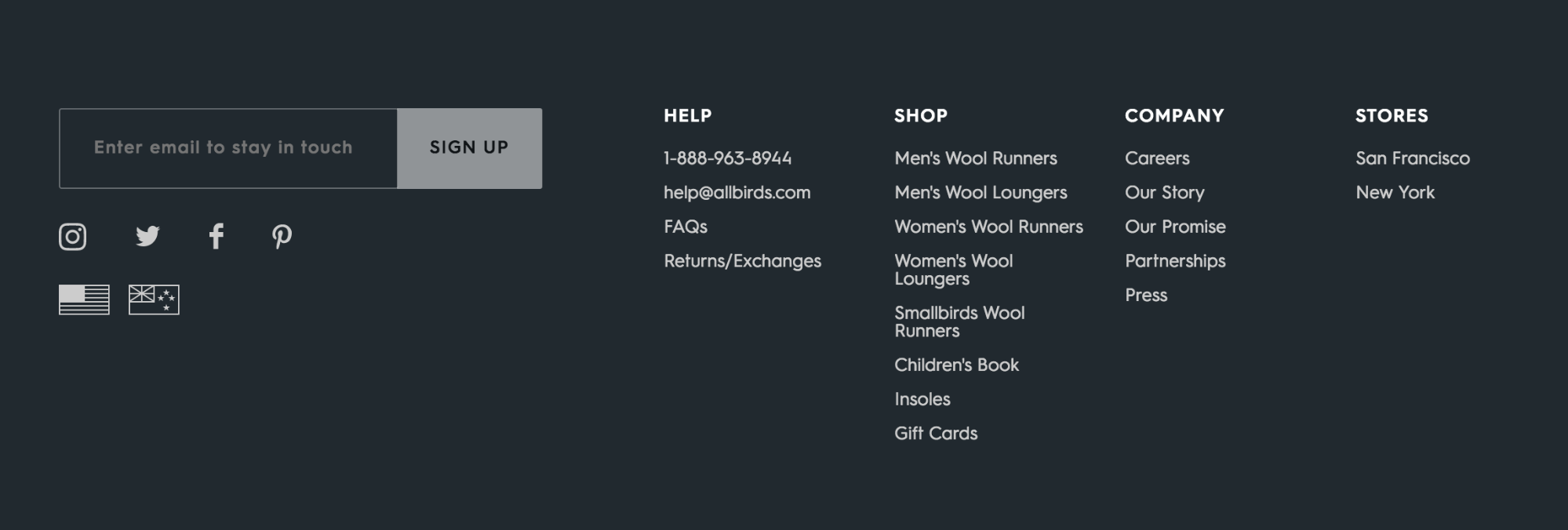
- Underneath your blog content

- The sidebar of your website
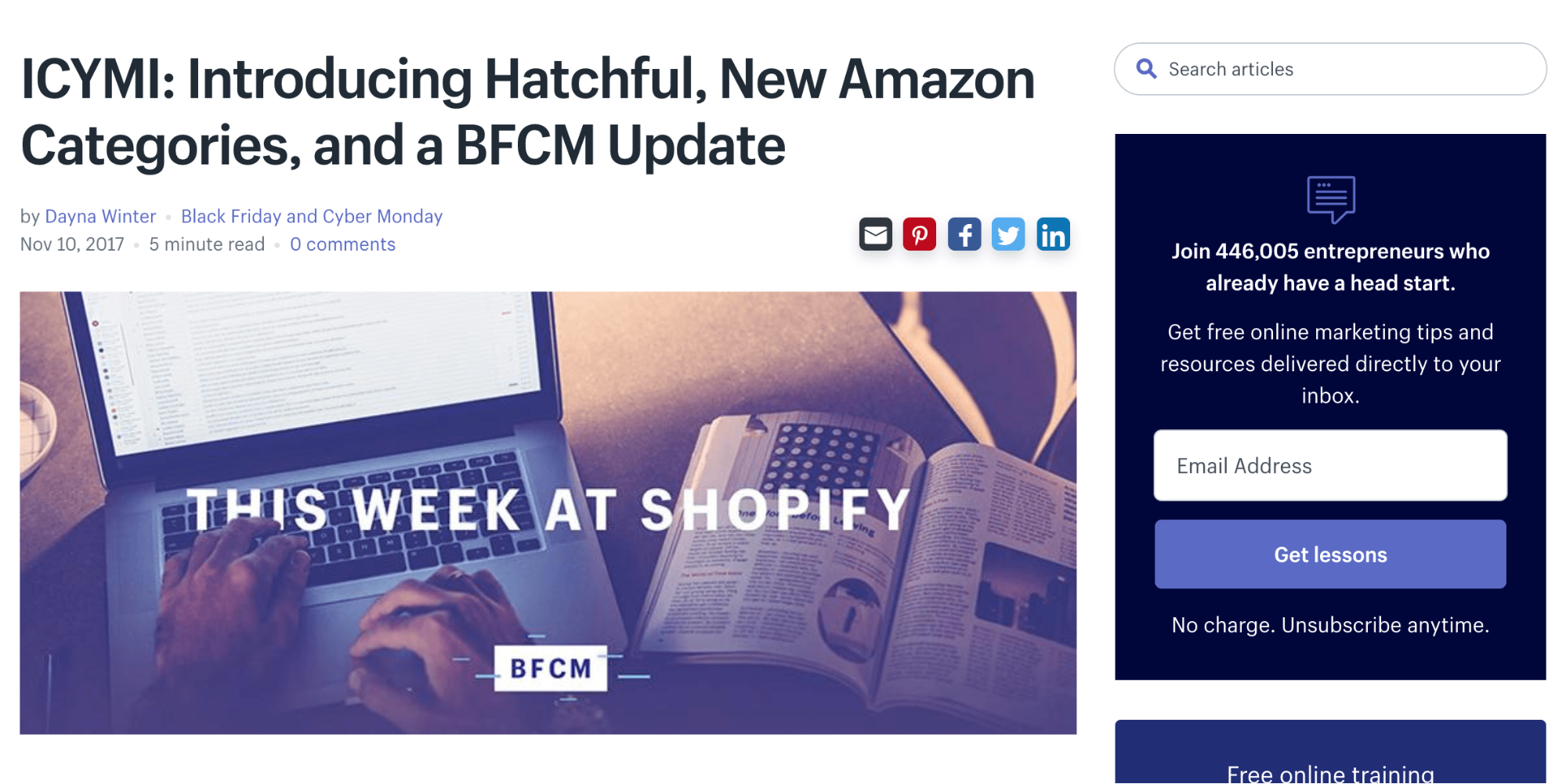
2. Work With Influencers
Influencer marketing means working with people who influence your potential buyers.
For example, if you’re an up-and-coming basketball store, selling your own brand of basketball socks, you might look at well-known basketball bloggers and social media accounts as influencers over your target market.
Accounts like Dunk, with over 2.2 million (!) followers on Instagram:
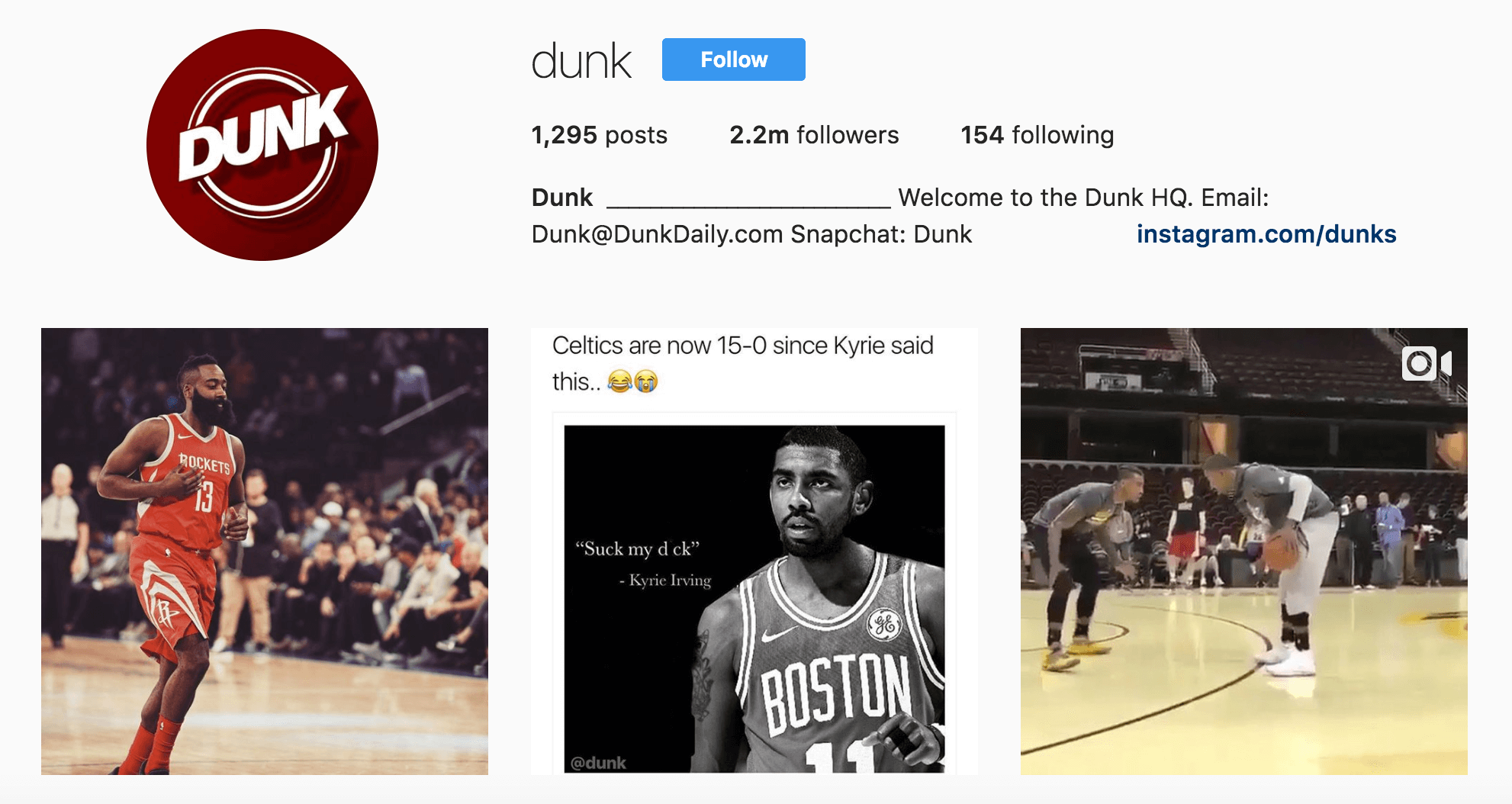
Or Lethal Shooter, a basketball shooting coach, with over 500k followers on Instagram and more than 250k views on his YouTube channel:

These influencers reach a vast number of basketball players online, and if they were to talk about your basketball socks, it could help to increase the traffic to your ecommerce store.
To uncover the best influencers to work with, start making a list of keywords related to your product. So for my basketball socks, I might think about “basketball accessories”, “basketball training”, “basketball shooting tips.”
Then, take these keywords and find the social media accounts and bloggers who influence those areas. To find influential bloggers, I might head to Google and search “best basketball accessories blogs.”
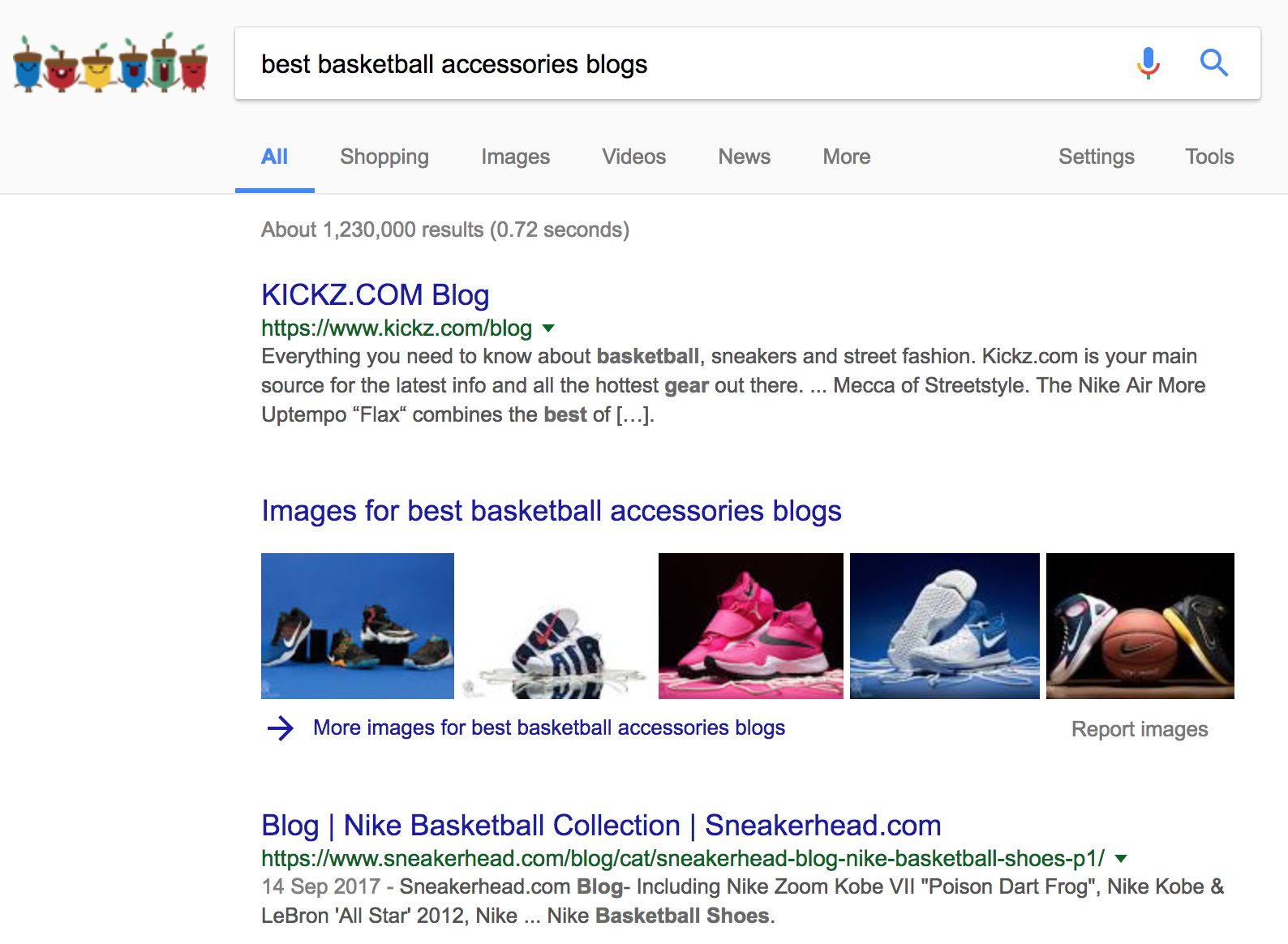
And find sites like WhatsMyVertical.com that regularly posts roundups of the best basketball accessories:
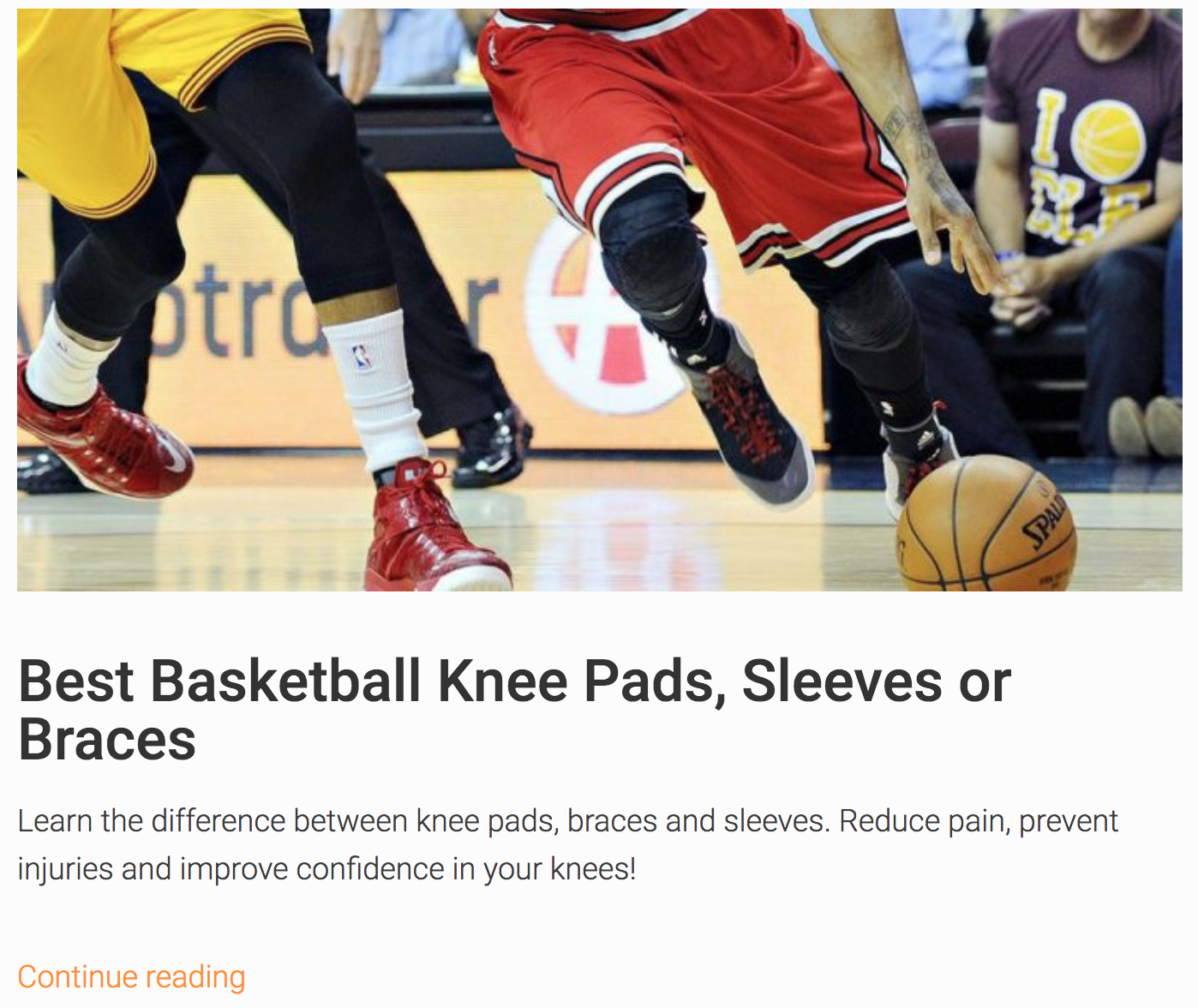
When it comes to finding influential vloggers or YouTubers, go to YouTube and search for your keywords in the main search bar to find people who regularly create content related to your business.
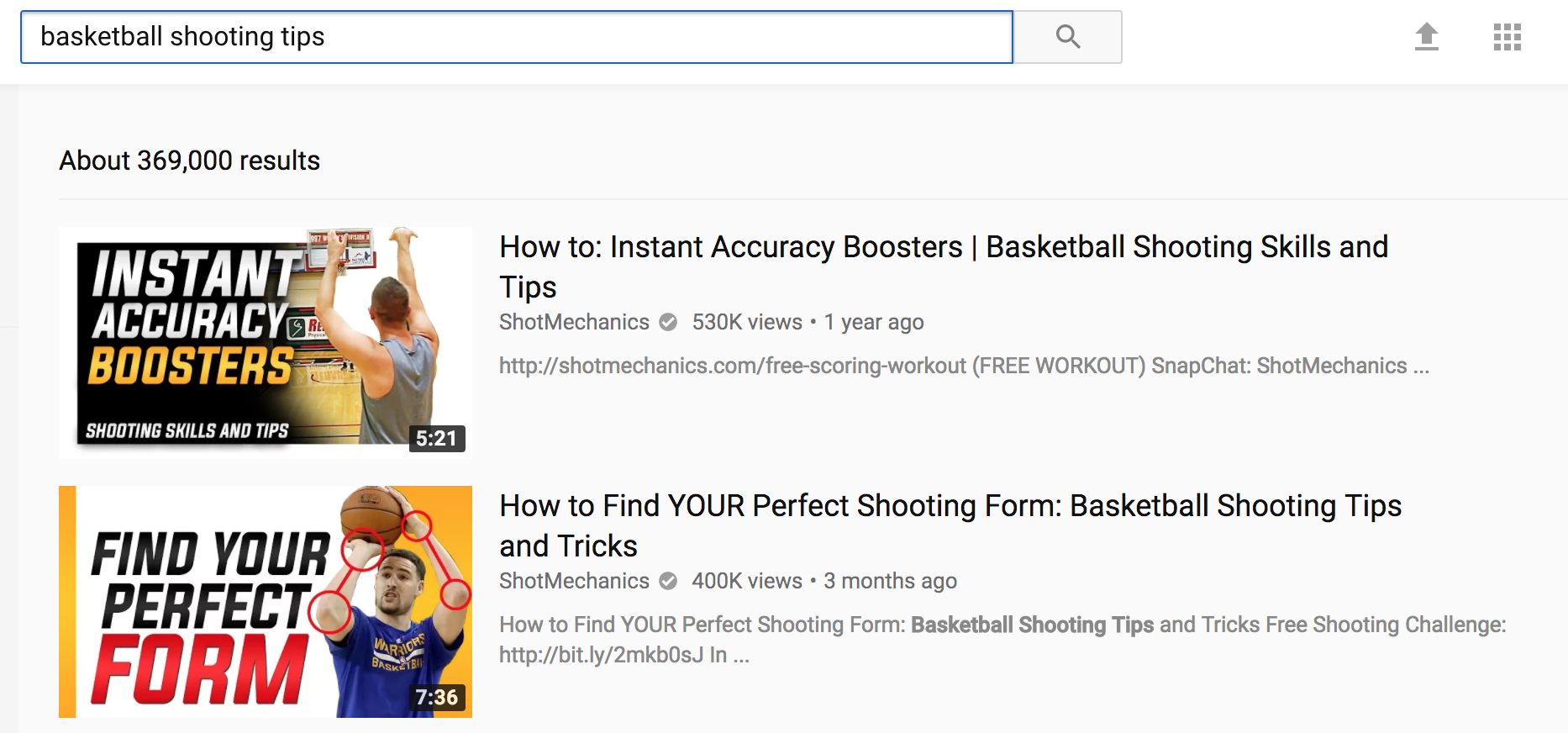
To find social accounts who might influence your target audience:
- For Instagram: Search Webstagram (a site that enables you to search hashtags and bios on Instagram), using keywords related to your business.[*]
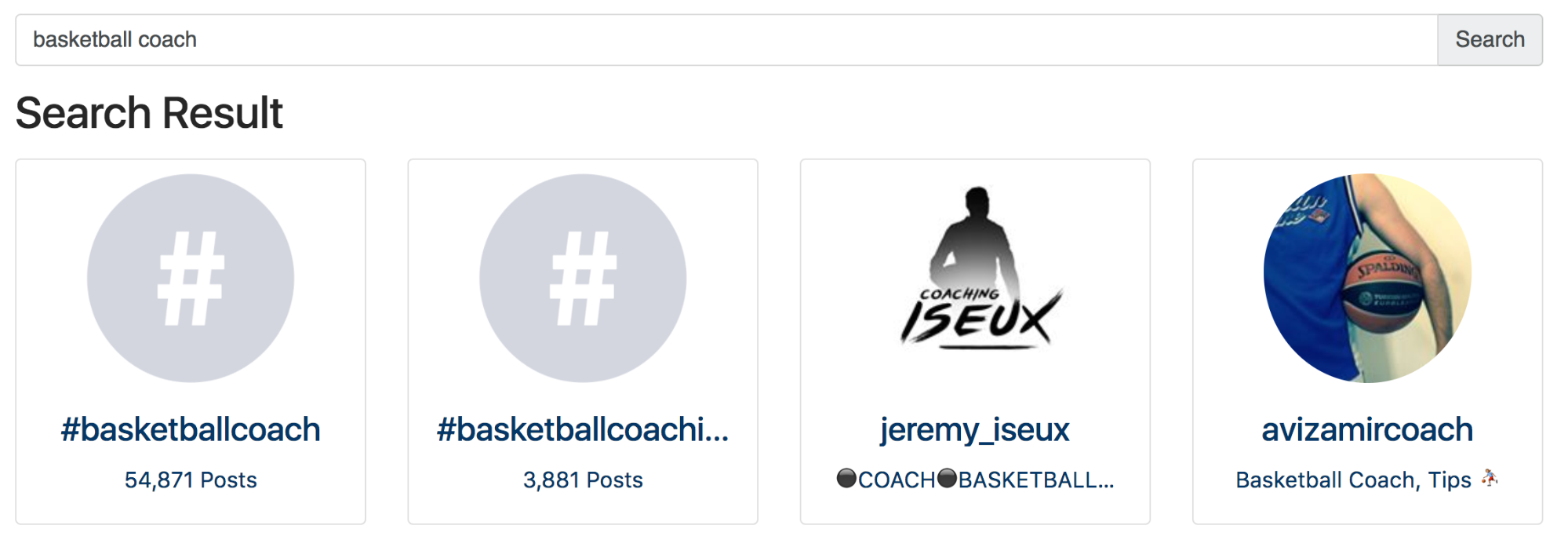
- For Twitter: Use Followerwonk to search Twitter profiles and uncover people with relevant keywords in their bios.[*]

- For Facebook: The best option is Facebook Search. Open up Facebook and enter your keywords into the search bar. Then, click “Pages”.
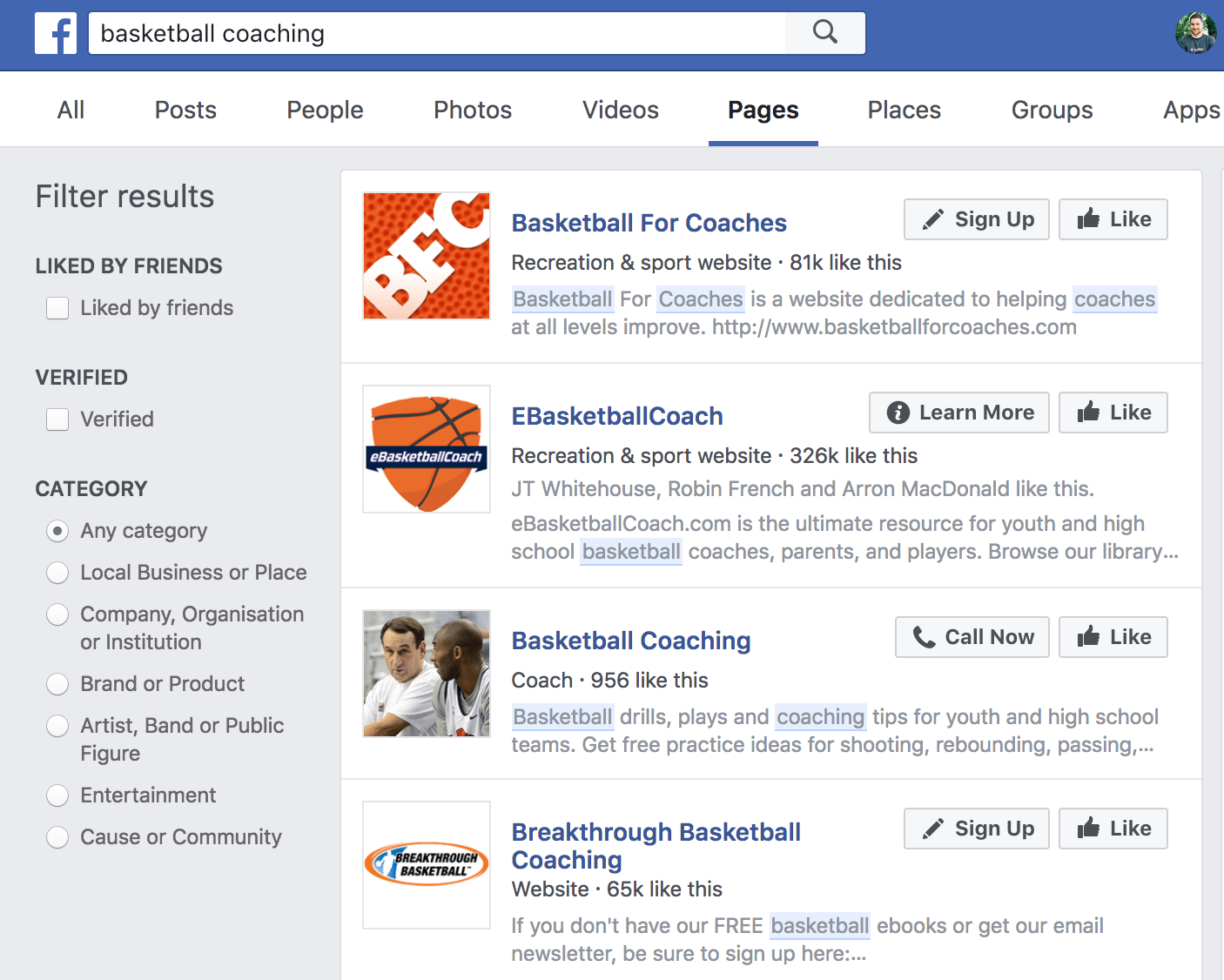
Note: Think specifically about what your audience will be looking for. For example, basketball highlights might be watched by fans, whereas training drills related content will be mostly for people who play basketball (and own the product I’m selling… basketball socks).
Once you’ve compiled a list of influencers, it’s time to start reaching out to them about working together.
Typically, any influencer who works with brands will have their contact information listed in their bio—or at least a link to a contact page.
You can see below that Dunk has their email listed on Instagram:
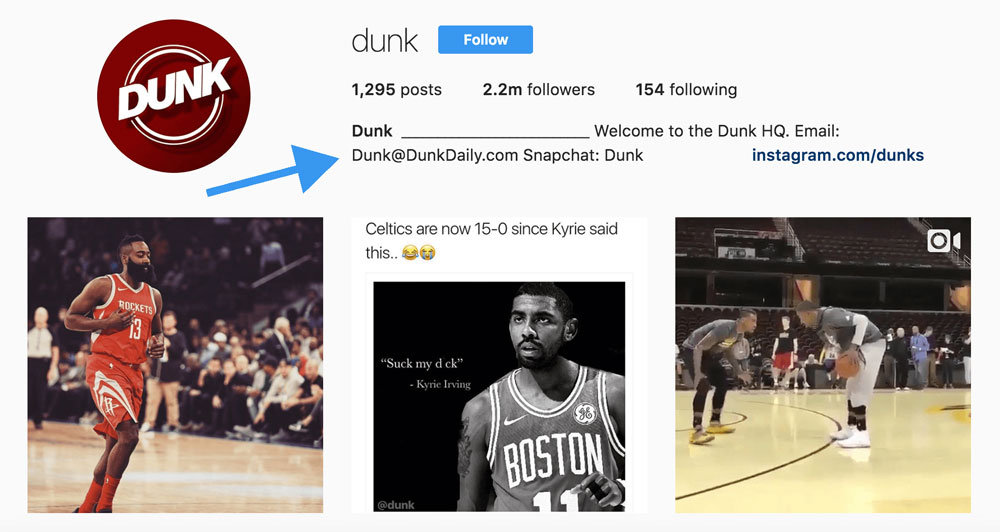
If no email or contact page is listed, you could drop them a quick DM or comment on one of their posts about working together. Here’s a super quick template you can copy + paste:
“Hey [Name], would love to discuss working together on something. What’s the best way to get in touch?”
Once you have the contact details for each influencer, drop them a message:
Hey [Name],
Ash from Crossover Socks here. Been following you on Instagram for a while and I’d love to send you a free sample of our product.
We’ve been endorsed by [well-known name here] and featured by [publication].
What’s the best address to mail your sample to?
Also, keen to hear your rates for sponsored posts or brand shoutouts. Would love to work together sometime.
Cheers,
Ash
Note: When you’re working with influencers, you don’t always need to work with the accounts that have the biggest following. Sometimes, people with smaller, more dedicated followers can be much more effective.
For example, Markerly found that influencers with 10,000-100,000 followers can generate more engagement that larger accounts.[*]
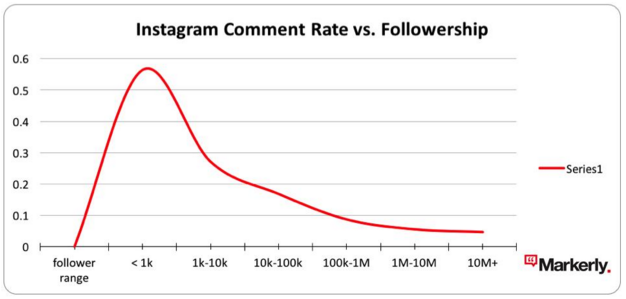
Another way to work with influencers is to interview them and feature them on your site. On his podcast, Noah Kagan Presents, and blog, Noah often interviews influencers such as Tim Ferriss:

When you feature an influencer on your site, there’s always a good chance they’ll share it with their audience and drive more traffic back to your site:
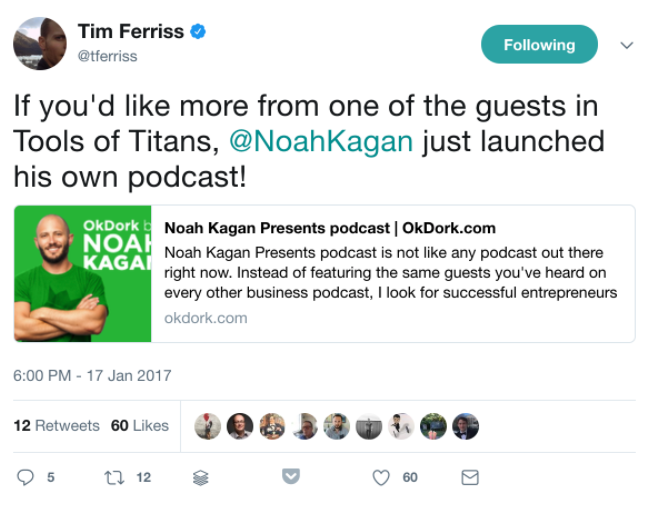
Think about which influencers you could interview on your site and reach out to them using this template:
Hey [Name],
Ash from Crossover Socks here. I’m a huge fan of your videos on Instagram and I’ve been trying to work on my shot based on your content (dropped 22 in a rec game last week! thanks!).
We’re launching our blog soon, and I’d love to feature you and talk about [topic related to your target audience].
We’ll be promoting the content by [list here, maybe: Facebook Ads, syndication, Facebook Pages, Twitter, etc].
This should only take 15 mins of your time. Up for it?
Cheers
Ash
3. Start Blogging
Content marketing is a great way to boost your traffic and also establish authority on topics closely related to your business.
For example, Death Wish Coffee, an ecommerce store selling the world’s strongest coffee, often blogs about topics related to their business, such as:
- How to Have a Great Day
- Ways (That Aren’t Coffee) to Wake Up Early
- These Are The Best Coffee Shop Names We’ve Ever Seen

When you check out their blog, you’ll notice every page also features links to make purchases from their store.
They have “Buy Now” buttons on the sidebar:
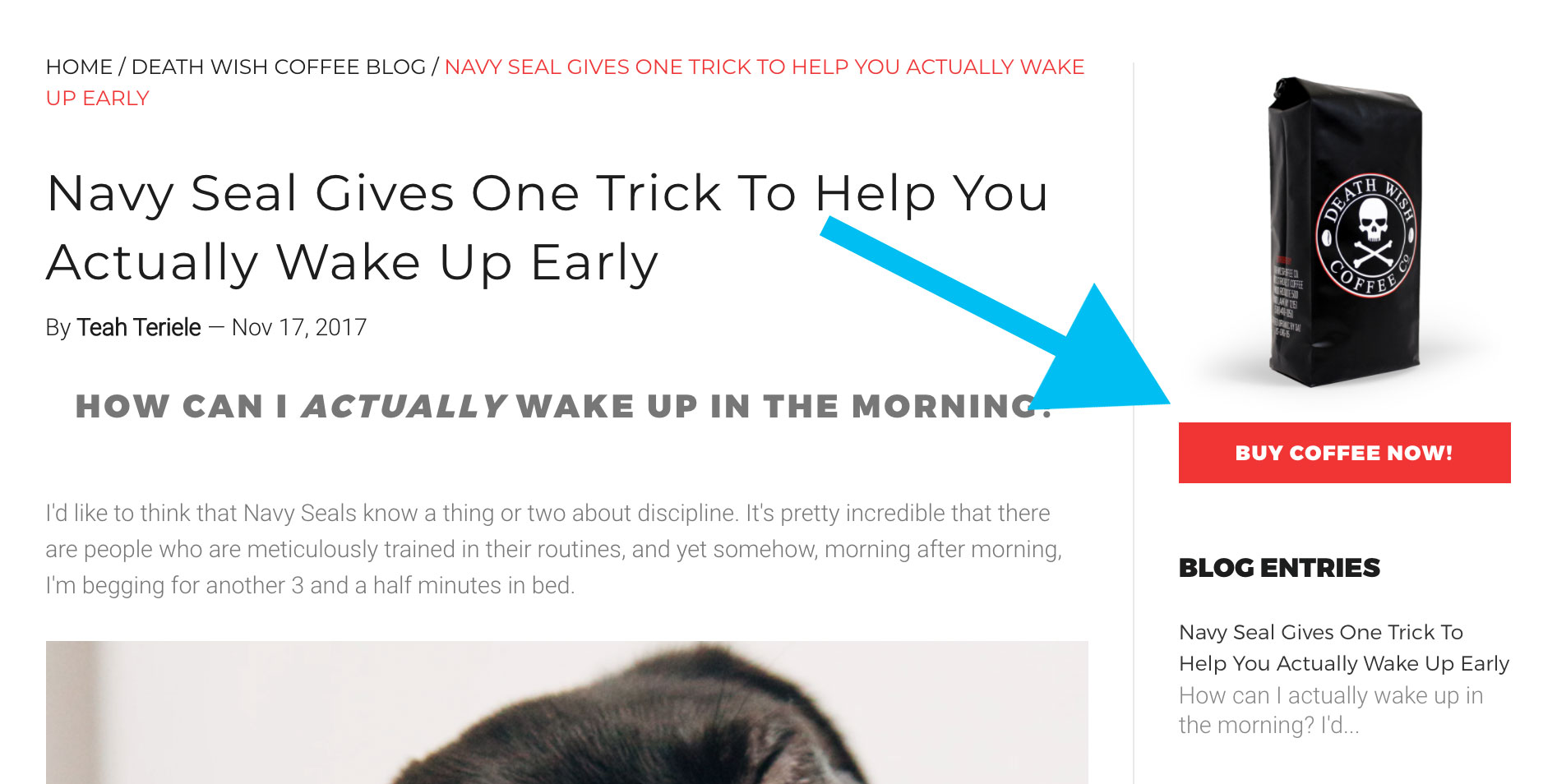
Their blog footer features links to different areas of their ecommerce store:

They also use their blog as a way to capture email addresses and grow their email list:

So every single visit to their blog creates a bunch of opportunities for people to either make a purchase or subscribe to their updates.
When you start a blog, you create new opportunities for people to discover your store and every new blog post is a potential traffic goldmine.
For example, posts from Death Wish Coffee’s blog rank well in Google for highly specific coffee related keywords like ‘how to make coffee’, ‘how to use a coffee maker’ and ‘how to drink black coffee.’

Ahrefs estimates that the three keywords listed above bring in around 900 visits/month to the Death Wish Coffee website.
In total, Ahrefs estimates that their blog will bring in over 9,000 visits per month just from organic search traffic. That’s 9,000 people discovering their content every month without Death Wish Coffee having to spend a dime on advertising or paid promotion.
Not all keywords will have high purchase intent, but getting their brand in front of coffee lovers provides them with opportunities to nurture and convert visitors to customers over time.
Another way content can drive traffic is through social sharing. And Death Wish Coffee has some highly shared posts on their blog:
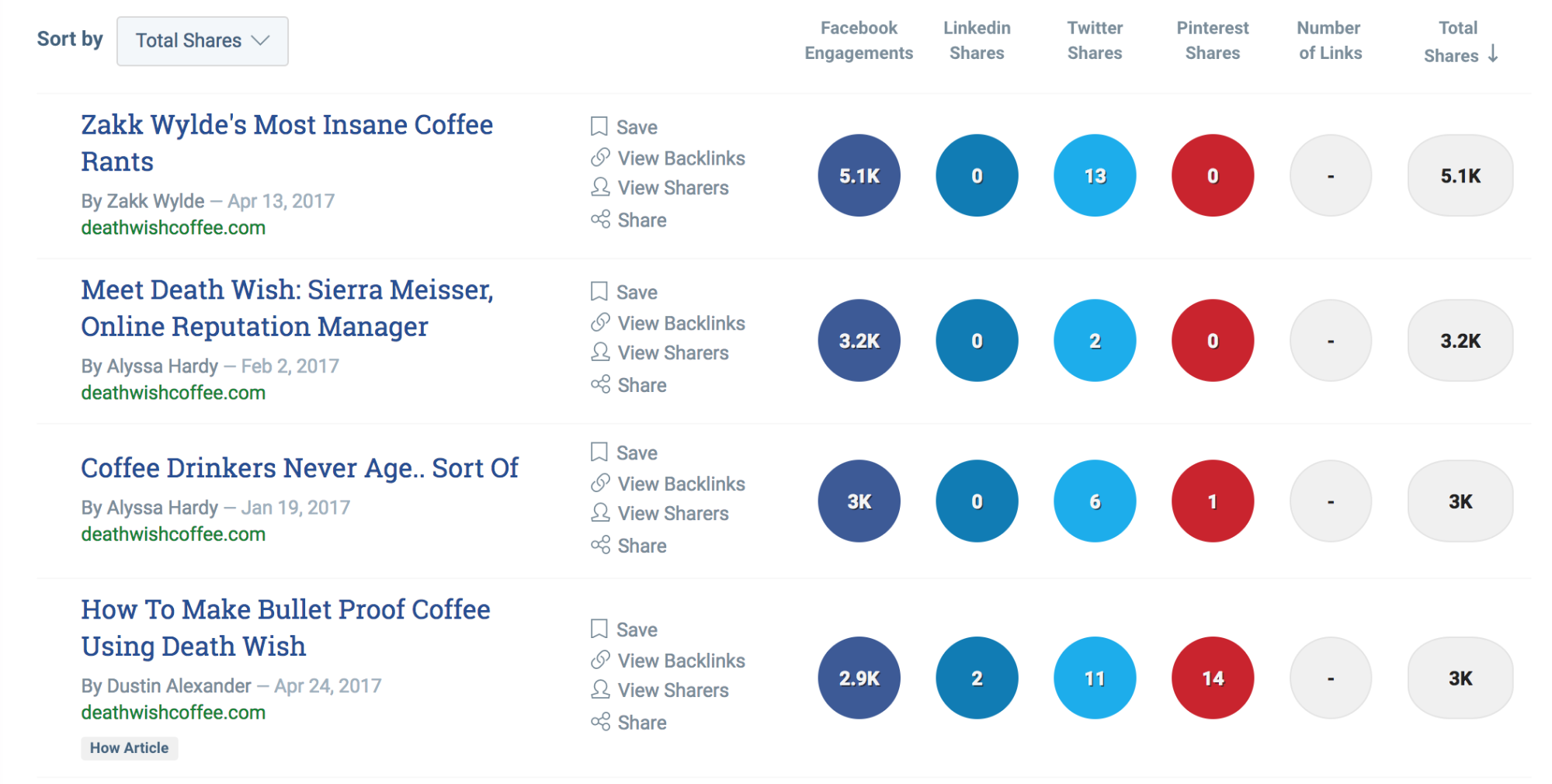
These four posts in the above image account for more than 14,000 shares, helping to generate a ton of awareness and traffic back to their blog.
For a complete guide to getting started with blogging and growing your site from 0-10,000 monthly visits, check out this post.
4. Run A Giveaway
People love free stuff 😍
Just ask Julien, who used a giveaway to grow his blog from 0-10,000 visitors in a month. The great thing about Julien’s giveaway is that he started from next to nothing. He had almost zero traffic and just 173 people on his mailing list when he launched the giveaway.
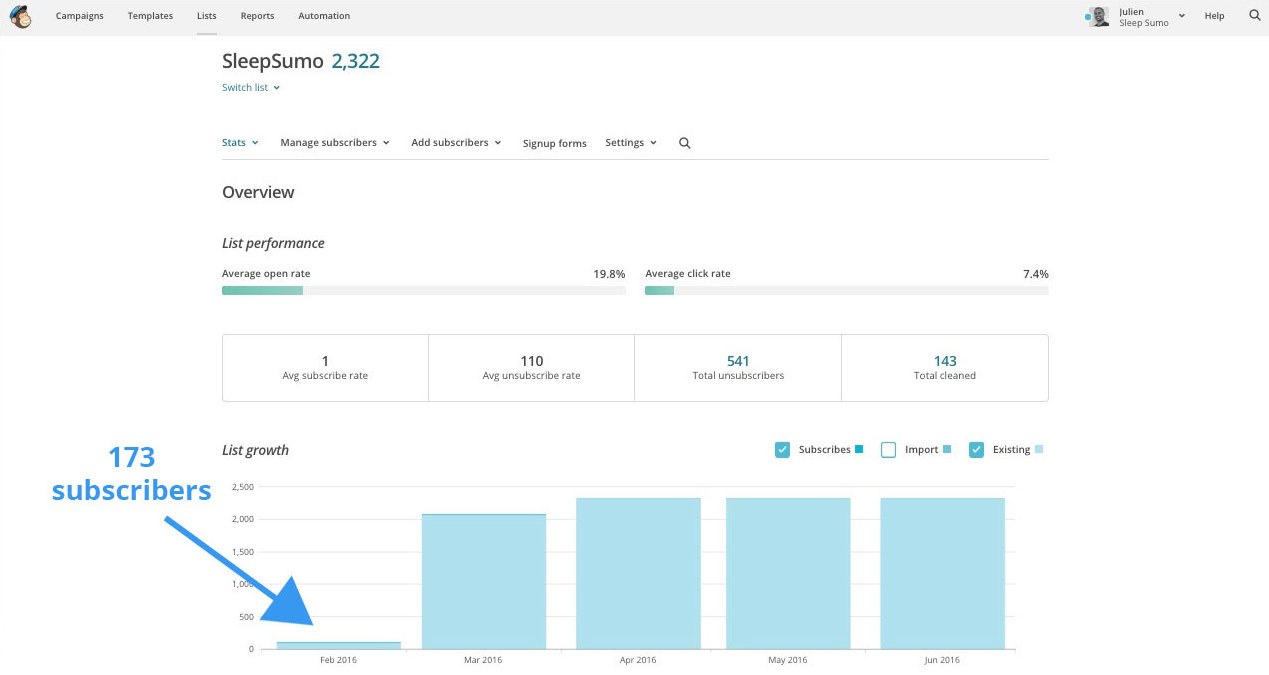
So if Julien can do it, then you can too—especially if you already have a bit of traffic and a mailing list.
Another great example is BeardBrand, who used a giveaway to drive some incredible results:[*]
- 1,248 new email subscribers
- 1,041 new Facebook fans
- 562 new Twitter followers
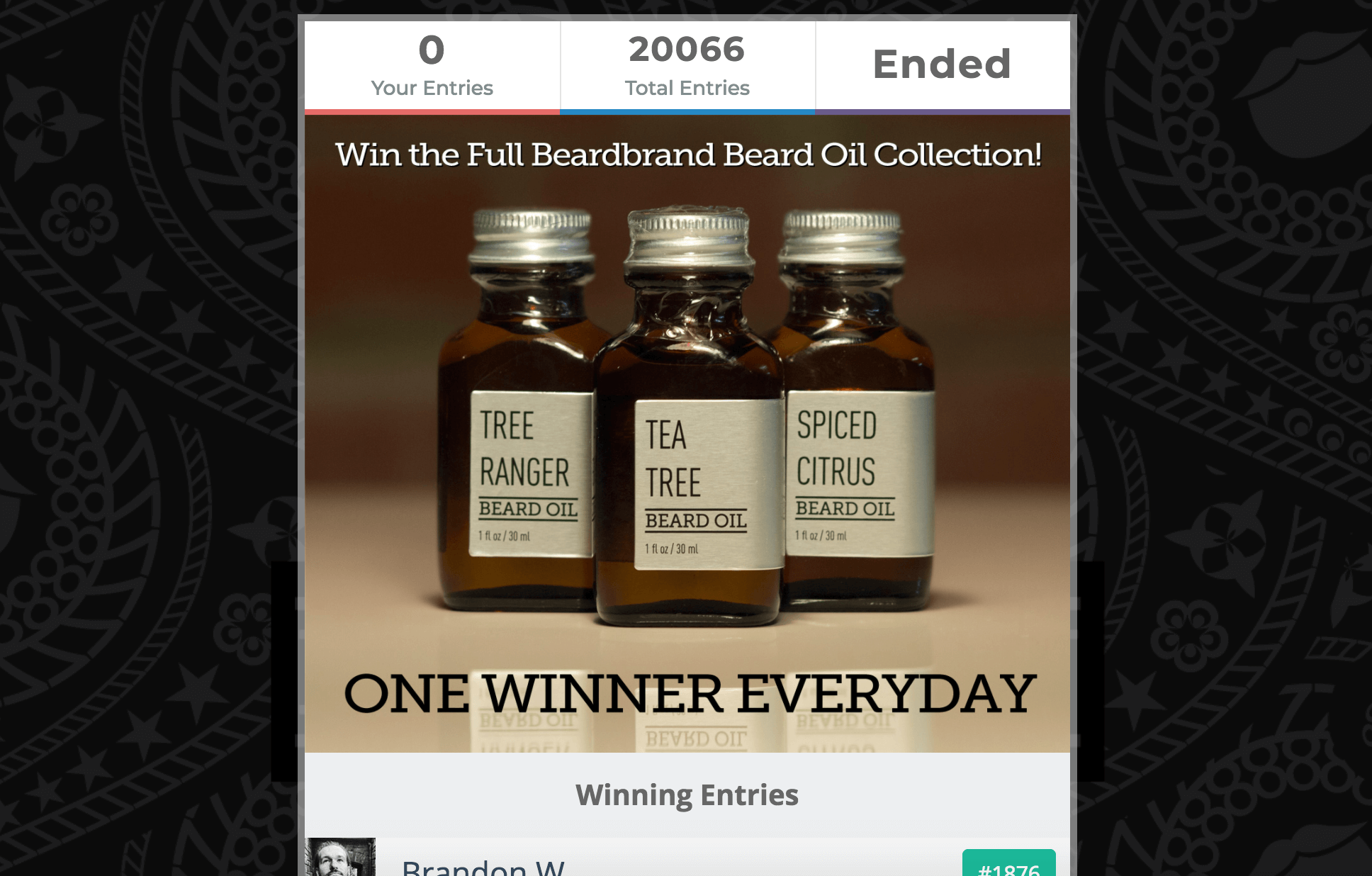
Plus, they also recorded their largest revenue day ever during the giveaway period. Not only did these new subscribers boost traffic to BeardBrand’s site during the campaign, but they also enabled Beardbrand to continually drive additional traffic from their social media profiles and email list.
To run a successful giveaway, you need:
1. A clear goal
What would success look like for this campaign? Do you want to drive a ton of traffic to a specific landing page? Or maybe you want to build your email list so you can get more leads into your funnel?
Make sure your goal ties back to your overall goal of increasing the traffic to your ecommerce site.
2. An exciting prize
During his giveaway, Julien rounded up a ton of fantastic prizes to help the winner improve their sleep (his blog was on optimizing sleep), and BeardBrand gave away over $500 worth of beard oil to entrants of their competition.
If you want people to enter, your competition must have relevant, exciting prizes.
Here are some ideas to get you started:
- Special/limited edition versions of your product
- Free tickets to an event
- Travel
- A behind-the-scenes experience at your store
- VIP shopping experience
- Vouchers
- Free products
A great example of having a relevant, exciting prize is Cactus Club Cafe, who gave away a $100 gift card on their Instagram account, and to win you had to tag a friend on the post:
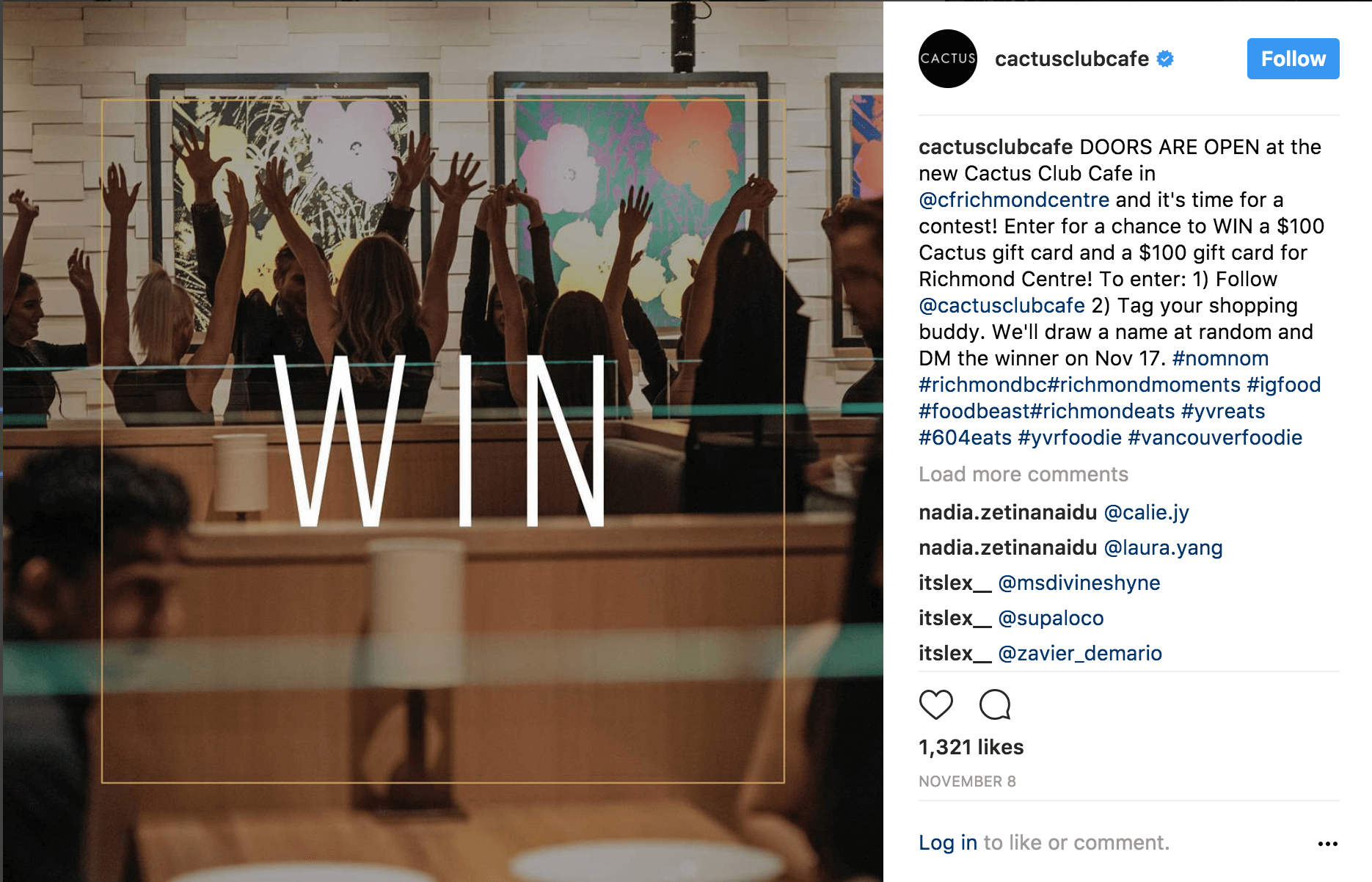
Note: If your goal is traffic, ensure your giveaway mechanic revolves around visiting your ecommerce store or encouraging other people to visit your site.
For example, during BeardBrand’s giveaway, entrants were encouraged to share a link back to the giveaway landing page to increase their chances of winning:
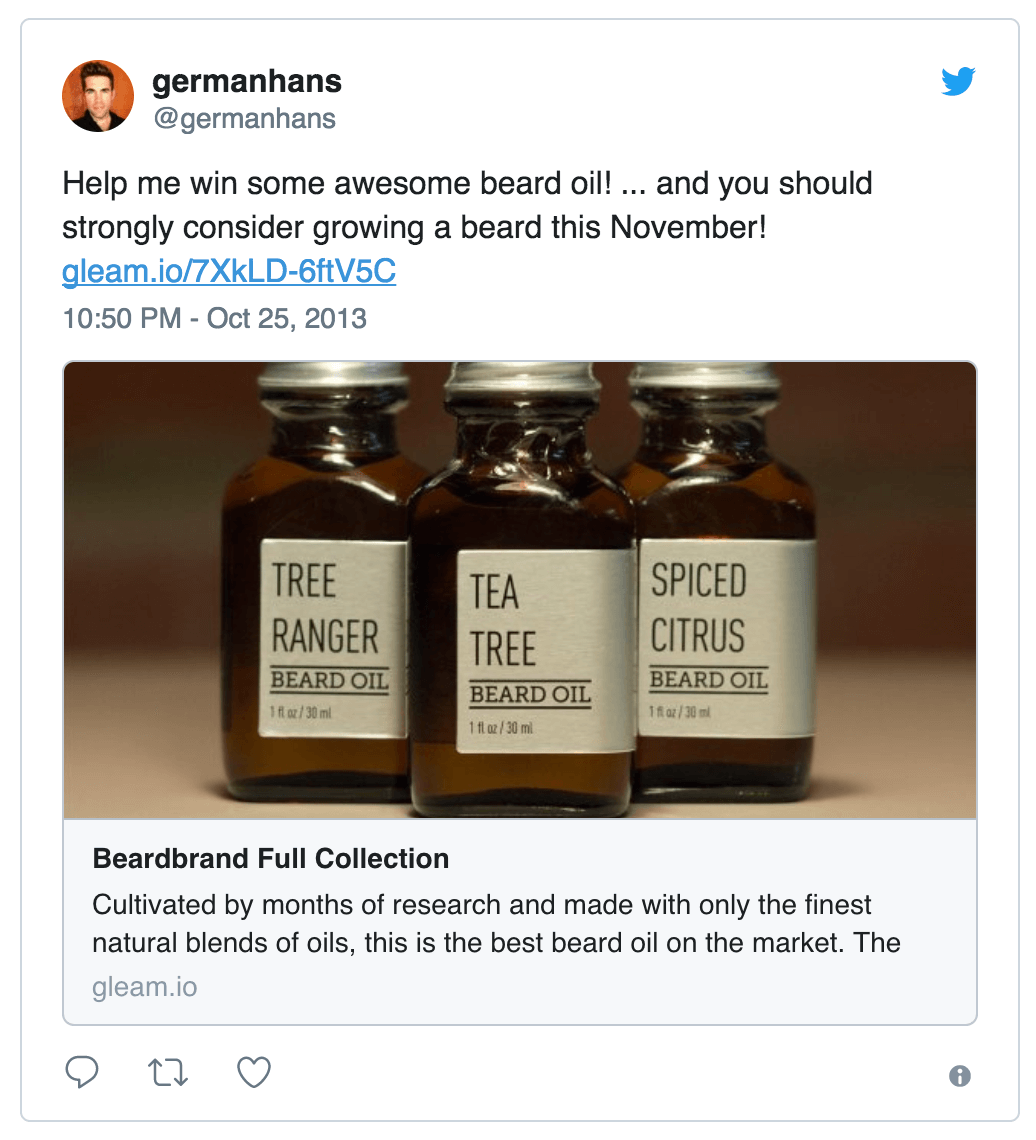
3. A promotion plan
If no one sees your giveaway, no one will enter it. It’s essential that you build promotion into your giveaway campaign.
One of the best ways to promote a giveaway is through a viral loop. Participants are encouraged to share on Twitter and Facebook to increase their entries (and therefore, their chances of winning) while also increasing the visibility of your brand and contest. There are some great tools out there like KingSumo to help with this.
During a recent giveaway Noah organized, over 10,000 entries were the result of people inviting others to join the giveaway.

Another way to promote your giveaway is through influencers.
Take some of the influencers you identified earlier in part 3 and reach out to them about working together on your giveaway.
You could ask influencers to:
- Provide prizes (if you sell/make any products)
- Promote the giveaway to their audience
Here’s a short, simple template you can use for your outreach:
Hey [Name],
I LOVE your products and would love to help get the word out.
My store, [Name here] is running a giveaway. We’re giving away [prizes here] and would love to partner with you too.
I feel your [product] would be a great compliment to the prize[s] we’re already giving away and if you’re up for helping us promote the giveaway, we’d happily share all the leads generated with you, too.
We’re aiming for [target here] entrants and will be launching the giveaway on Tue, 29 Apr 2025 20:23:30 +0000.
Sound good?
Cheers,
Ash
5. Launch A Referral Program
Word-of-mouth marketing can be an incredible way to grow your traffic (and boost sales).
It’s no secret that referrals from friends is the #1 trusted source of advertising.
And I can testify to the power of referrals myself…
Every single day, I’ll check out links and content passed onto me by my friends because if someone I trust is recommending it to me, it must be good.
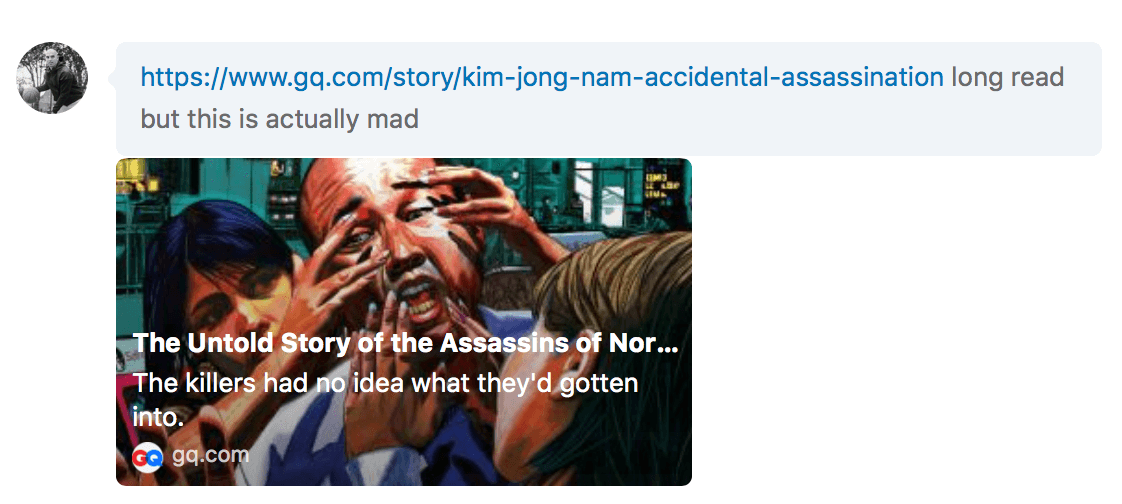
And the same goes for products, too.
After receiving an email from a friend, like the one below, I became (and still am) a Graze customer:

If you can get people to refer their friends to your ecommerce site, you WILL increase your traffic. If you’re looking for people to refer their friends to some of your content, sometimes all it takes is a simple ask.
Check out how Noah adds simple share CTAs to his podcast show notes:

This type of traffic is great to spread awareness of your business/brand and can help you to get on the radar of more people in your target audience. It’s a long-game play for sure, but you can see how this type of traffic can eventually turn into revenue for your business:
- I share Noah’s podcast with a friend who’s into online marketing too
- They listen to the episode and decide to subscribe
- They listen to a few more episodes and hear Noah mention Sumo
- Decide to check out Sumo’s site for more info
- A little way down the line they decide to focus on growing their email list and decide to give Sumo a trial
^ this is a super-simplified funnel, but hopefully it illustrates the value in driving traffic back to your content through friend referrals.
But where referral traffic really starts to pay off fast, is by launching a referral program for your products/services.
For example, in each email they send out, Onnit offers their subscribers a $20 discount for referring a friend.
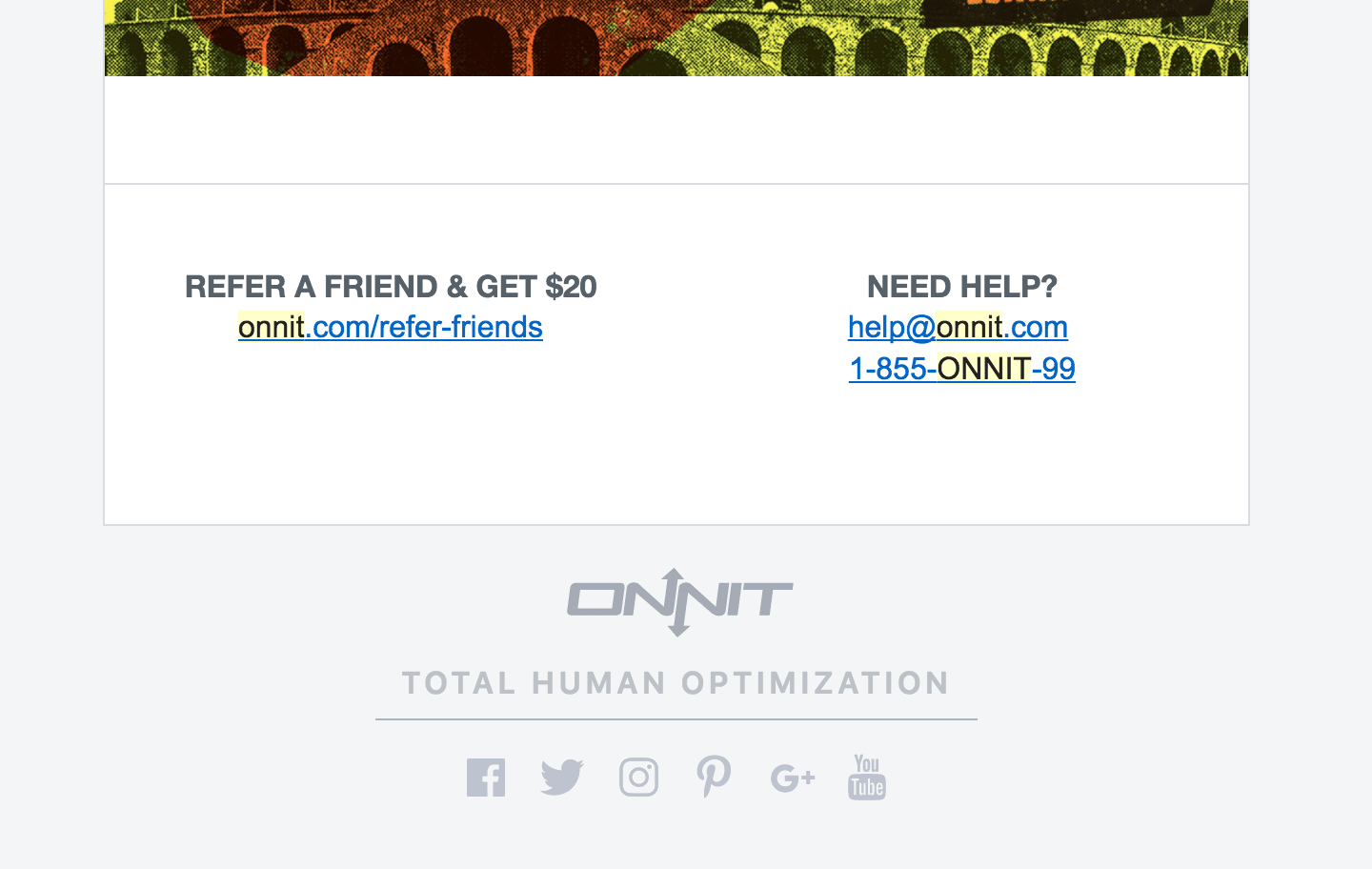
Once you click on the link, Onnit even provide pre-filled email, Facebook, and Twitter templates to make sharing super simple:
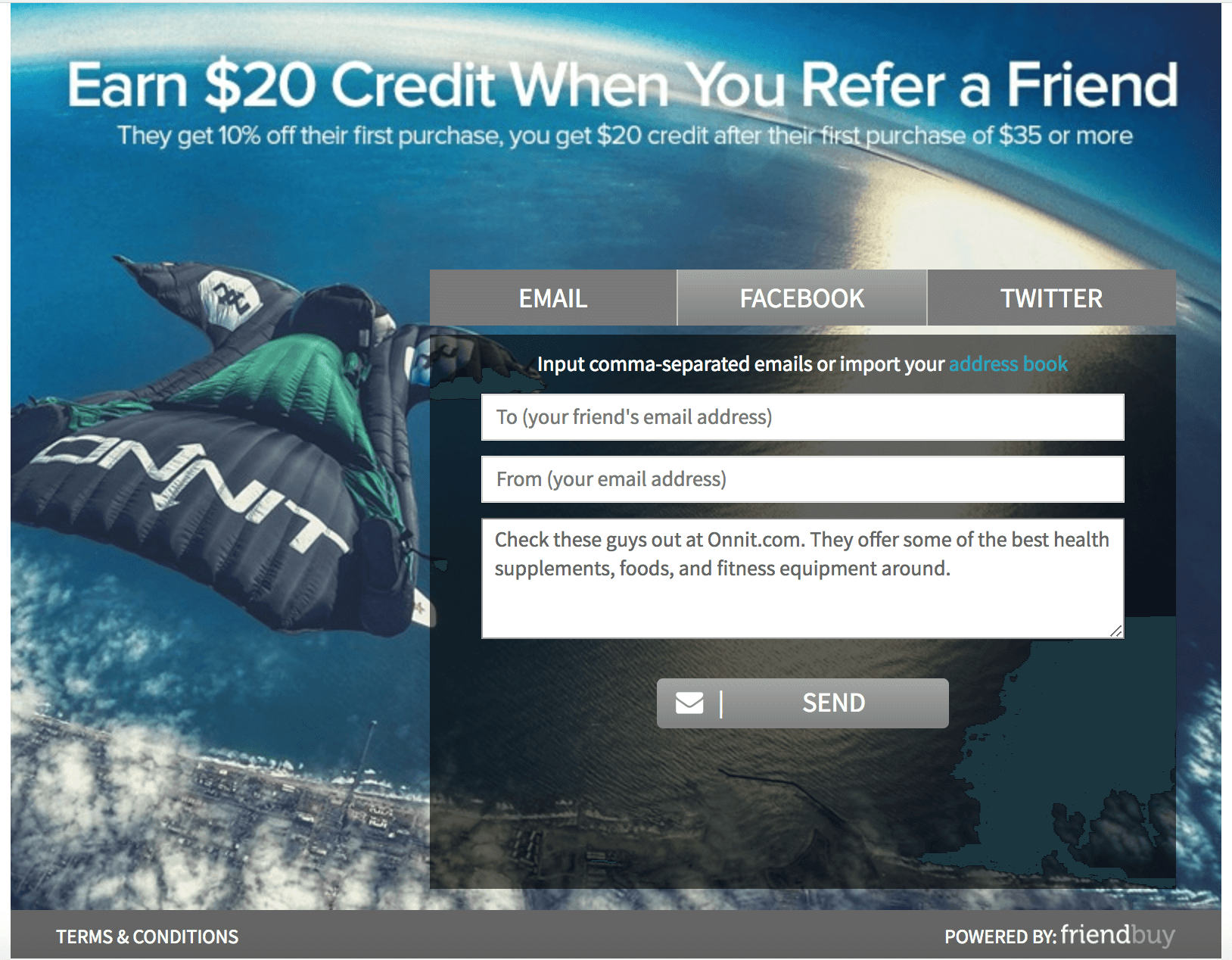
Sumo recently launched a limited-time partnership program with some exciting rewards for people who refer their friends and colleagues to Sumo:
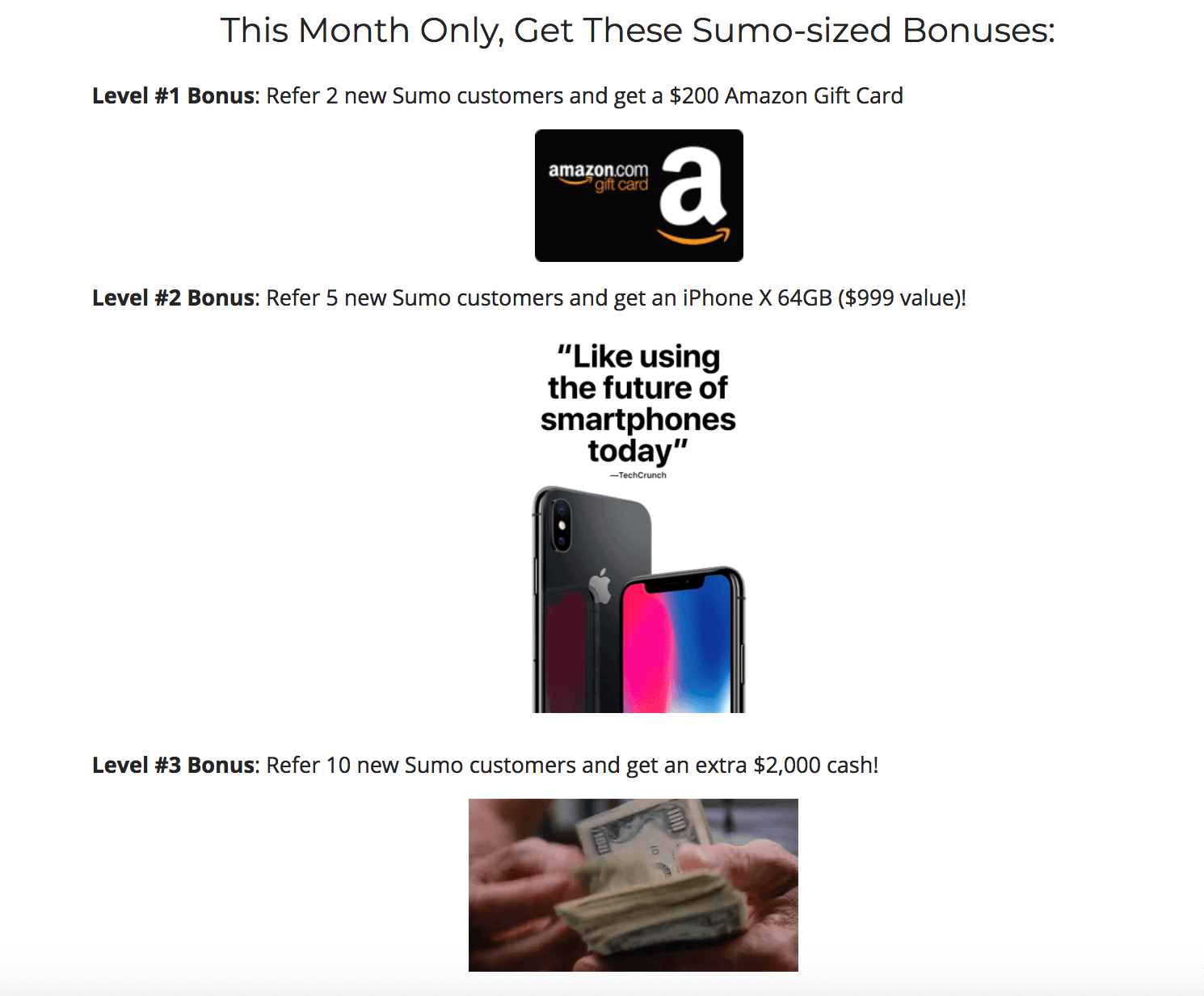
Evy’s Tree used a referral program to generate more than $1 million in revenue and create roughly 12 new partners a day from traffic generated by referrals:
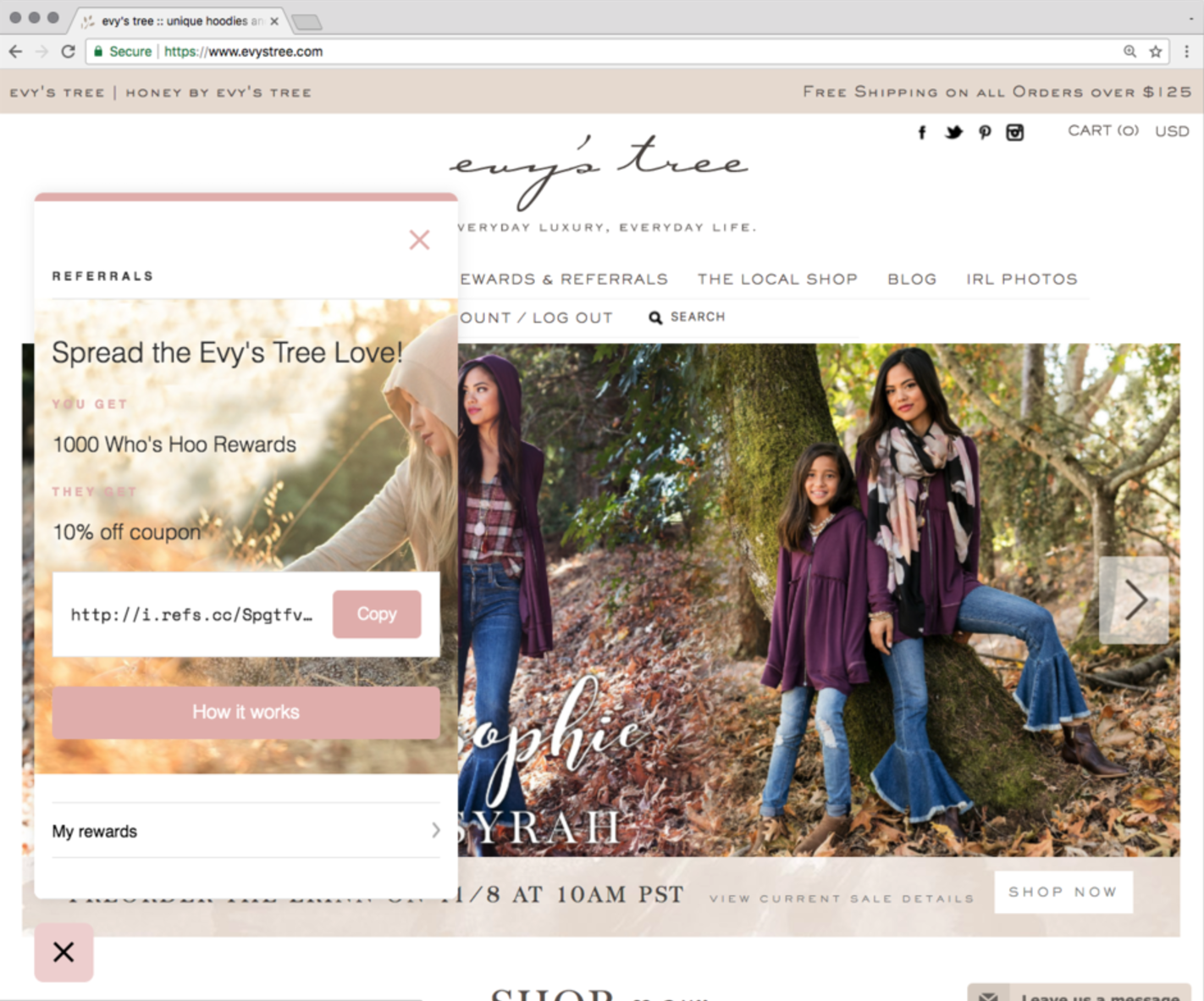
Customers could earn reward points for taking actions on Evy’s Tree’s online store:
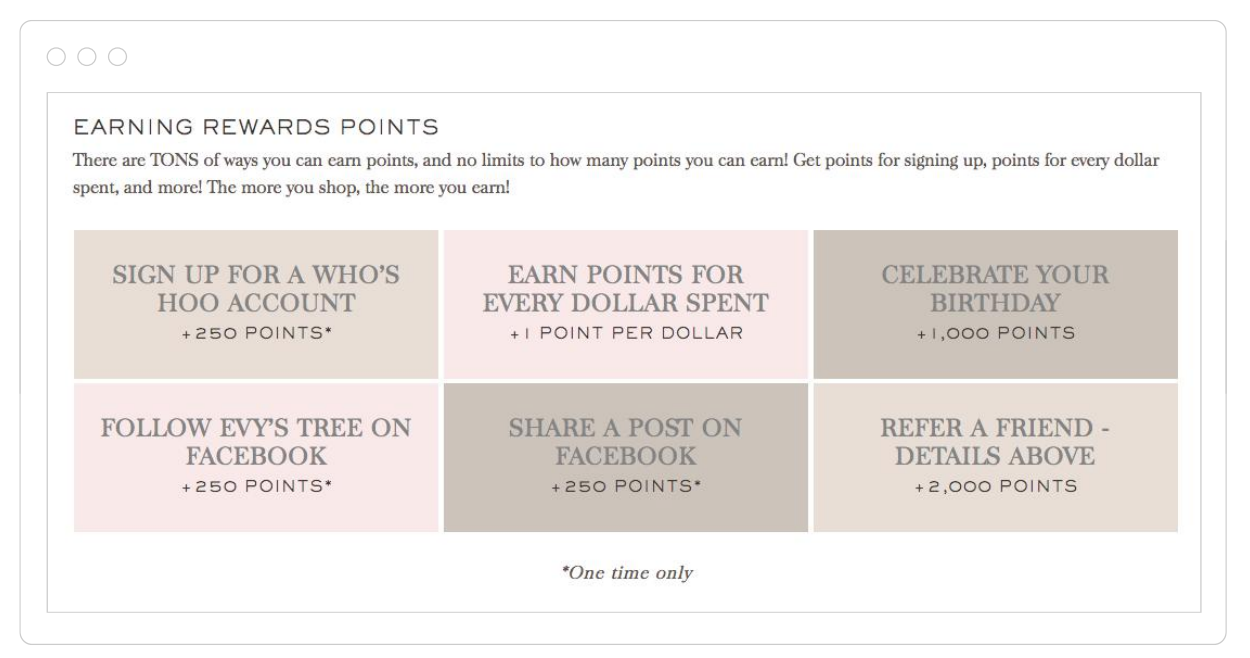
And then those reward points could be redeemed as in-store discounts:

To increase your ecommerce traffic through a referral program you need to do three things:
- Have a great product: Not all products are ready for a referral program. If your product doesn’t kick ass and have a bunch of loyal, retained users already, a referral program probably won’t do much for you as no one will share and it won’t increase your traffic.
- Offer an easy-to-understand reward: The most effective referral programs are super simple to understand, “Give A, receive B.” Take Sumo’s partner program: Refer five customers, you’ll receive an iPhone X. Simple.
- Make rewards two-sided: Evy’s Tree’s million dollar reward program worked so well because it was two-sided. For referring a friend, you’d get 1,000 points to spend in their store and your friend would get a 10% off coupon. Win-win situation.
If you run a store on Shopify, check out one of the best Shopify referral apps I found to create a referral program to increase your traffic.
6. Link To Your ecommerce Site From Your Social Bios
If you don’t get time to execute at least one of the above tactics, then you can easily do this one, because:
- It’s a super low-hanging fruit
- You can do it within minutes
Almost every ecommerce store now has a presence on a large number of sites across the web:
- Social media accounts: Twitter, Facebook, Instagram, etc.
- YouTube accounts
- Blogs
- Review sites
And a bunch more.
An often overlooked feature of these sites is there is almost always a place for you to add a link to your store. Many let this space go to waste. Don’t be that business. Use each opportunity to your advantage and drive traffic back to your store!
On Twitter, you can add a link to your bio:
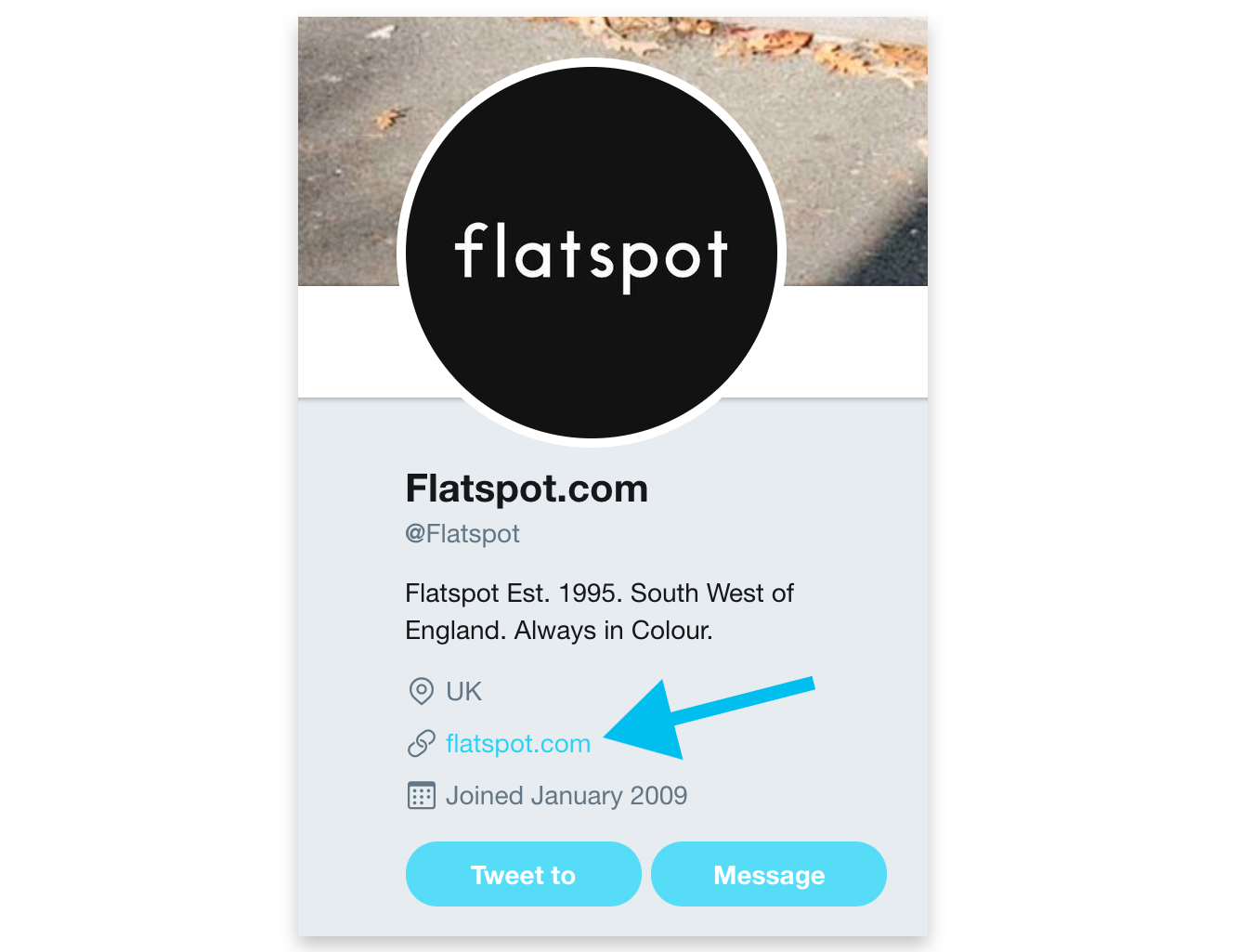
On Instagram, you can add a link to your bio:
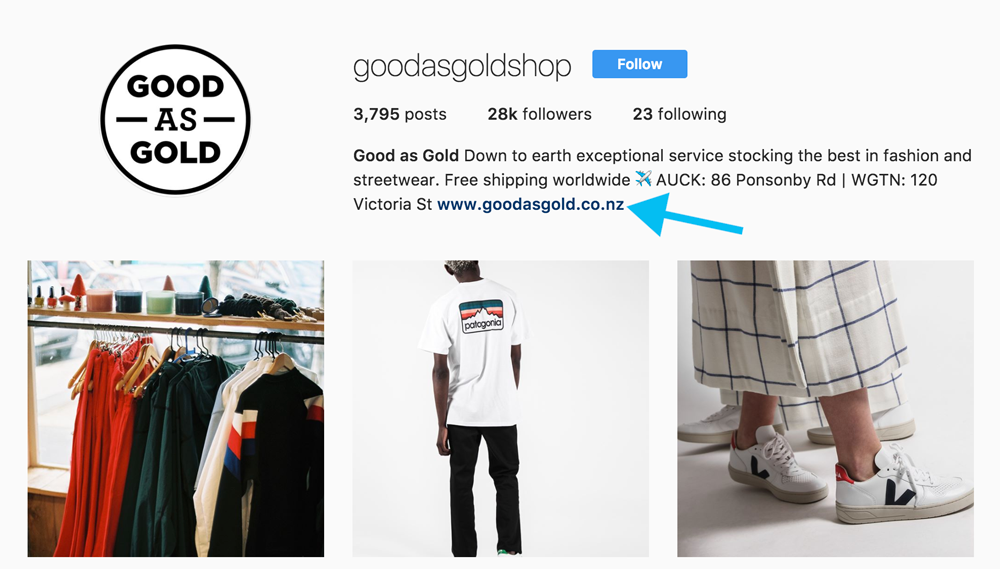
Note: The Instagram bio link is the only place on Instagram you can include a clickable link (unless you have a verified account and the ability to add links in Stories).
On Facebook, you can add a couple of links to your Page:
- A call-to-action button
- A link in your ‘About’ section

Firstly, you can add a call-to-action button to the top of your Page. This button is featured prominently at the top of your Facebook Page. To create/edit your button:
- Head to your Facebook Page.
- Click + Add a Button below your Page’s cover photo (or if you already have a button, click the edit icon on your button — in this case, we have the Shop Now button).
- Select a button from the menu and fill out any required information.
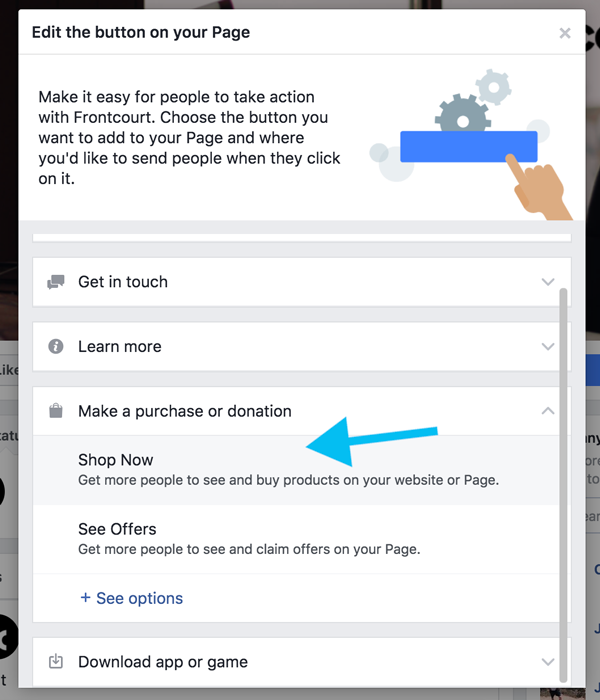
- Add the URL you’d like to direct the button to and click ‘Save’.
Secondly, you can add a link to your ‘About’ section. This will be displayed on the sidebar of your Page and also on the ‘About’ tab on your Facebook Page.
Which link should you use?
Most ecommerce stores tend to link to their homepage and 90% of the time, that’s probably the best place to direct people. However, you can also update these links to drive traffic to campaign-specific landing pages. For example, if you’re having a winter sale, you might want to link to mystore.com/sale.
Pro tip: Want to measure how many clicks these links get? Try a service like Bitly and create a unique URL for each platform so you can measure the effectiveness of each link.
If you’re not working on increasing your traffic, you’re missing out on sales
Traffic is the lifeblood of any online store. If people aren’t visiting your site, you’re missing out on sales.
One of the best ways to increase your sales is to focus on getting more people to your online store.
Start testing out these six tactics today to ensure you’re bringing as much traffic to your ecommerce store as possible.
More traffic = more sales!
Here is the slide presentation for a quick recap:
Add A Comment
VIEW THE COMMENTS